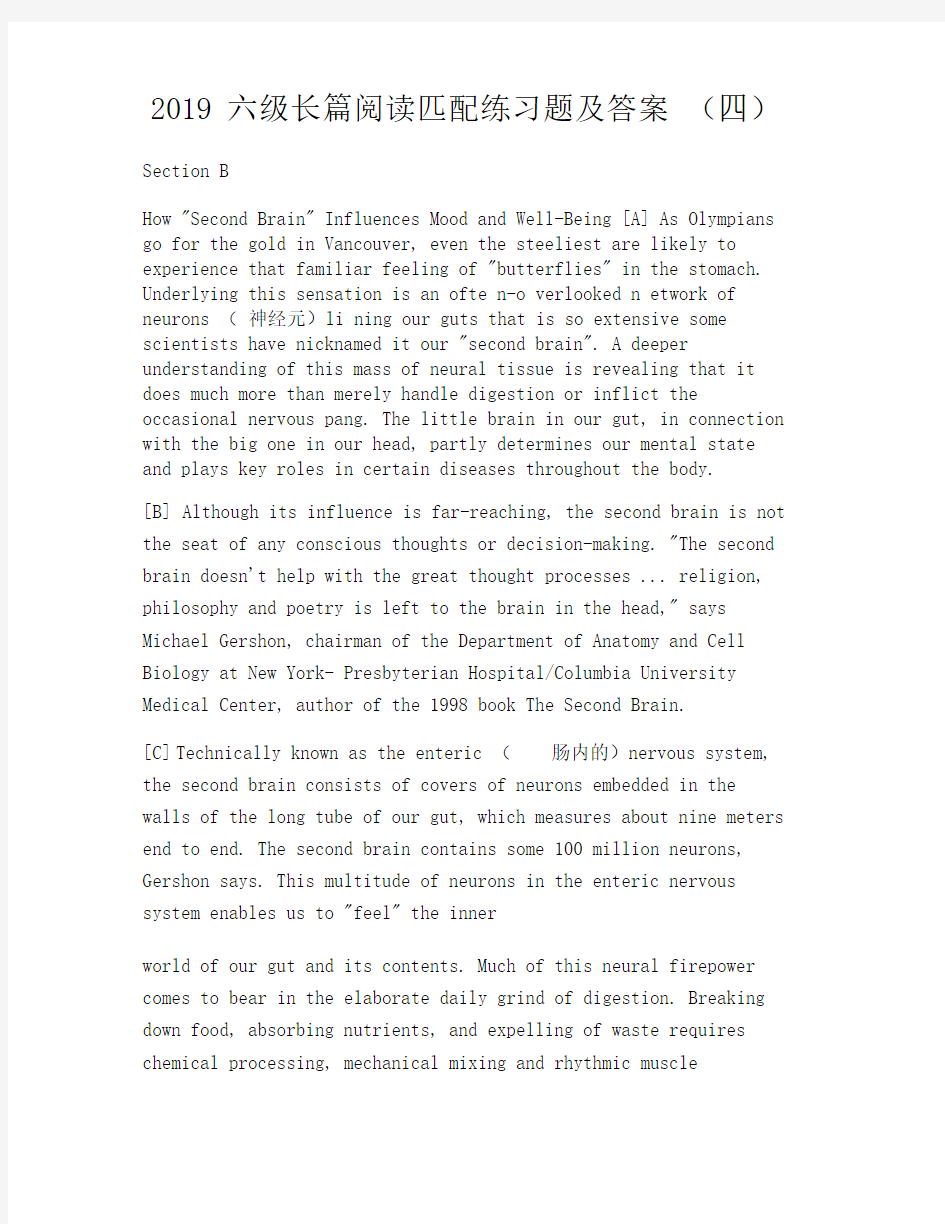2019六级长篇阅读匹配练习题及答案(四)

- 1、下载文档前请自行甄别文档内容的完整性,平台不提供额外的编辑、内容补充、找答案等附加服务。
- 2、"仅部分预览"的文档,不可在线预览部分如存在完整性等问题,可反馈申请退款(可完整预览的文档不适用该条件!)。
- 3、如文档侵犯您的权益,请联系客服反馈,我们会尽快为您处理(人工客服工作时间:9:00-18:30)。
2019 六级长篇阅读匹配练习题及答案(四)Section B
How "Second Brain" Influences Mood and Well-Being [A] As Olympians go for the gold in Vancouver, even the steeliest are likely to experience that familiar feeling of "butterflies" in the stomach. Underlying this sensation is an ofte n-o verlooked n etwork of neurons (神经元)li ning our guts that is so extensive some scientists have nicknamed it our "second brain". A deeper understanding of this mass of neural tissue is revealing that it does much more than merely handle digestion or inflict the occasional nervous pang. The little brain in our gut, in connection with the big one in our head, partly determines our mental state and plays key roles in certain diseases throughout the body.
[B]Although its influence is far-reaching, the second brain is not the seat of any conscious thoughts or decision-making. "The second brain doesn't help with the great thought processes ... religion, philosophy and poetry is left to the brain in the head," says Michael Gershon, chairman of the Department of Anatomy and Cell Biology at New York- Presbyterian Hospital/Columbia University Medical Center, author of the 1998 book The Second Brain.
[C]Technically known as the enteric (肠内的)nervous system, the second brain consists of covers of neurons embedded in the walls of the long tube of our gut, which measures about nine meters end to end. The second brain contains some 100 million neurons, Gershon says. This multitude of neurons in the enteric nervous system enables us to "feel" the inner
world of our gut and its contents. Much of this neural firepower comes to bear in the elaborate daily grind of digestion. Breaking down food, absorbing nutrients, and expelling of waste requires chemical processing, mechanical mixing and rhythmic muscle
contractions that move everything on down the line.
[D]Thus equipped with its own reactions and senses, the second brain can control gut behavior independently of the brain, Gershon says. We likely evolved this intricate web of nerves to perform digestion and ejection "on site," rather than remotely from our brains through the middleman of the spinal cord (脊髓). "The brain in the head doesn't need to get its hands dirty with the messy business of digestion, which is delegated to the brain in the gut," Gershon says. He and other researchers explain, however, that the second brain's complexity likely cannot be interpreted through this process alone.
[E] "The system is way too complicated to have evolved only to make sure things move out of your bowel," says Emeran Mayer, professor of physiology, psychiatry and biobehavioral sciences at the David Geffen School of Medicine at the University of California, Los Angeles ( U. C. L. A. ). For example, scientists were shocked to learn that about 90 percent of the fibers in the primary gut nerve, the vagus (走神经), carry information from the gut to the brain and not the other way around. "Some of that information is decidedly unpleasant," Gershon says.
[F]The second brain informs our state of mind in other more obscure ways, as well. "A big part of our emotions are probably influenced by the nerves in our gut," Mayer says. Butterflies in the stomach-signaling in the gut as part of our physiological stress response, Gershon says--is but one example. Although gastrointestinal (肠胃)(GI)chaos can sour one's moods, everyday emotional well-being may rely on messages from the brain below to the brain above. For example, electrical stimulation of the vagus nerve-a useful treatment for depression-may mimic these
